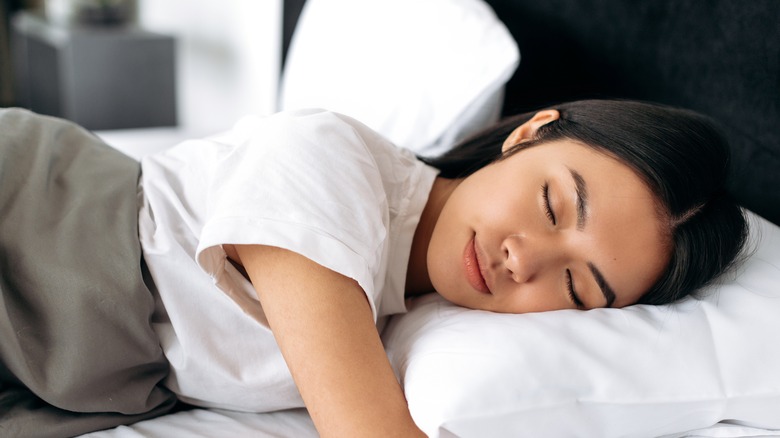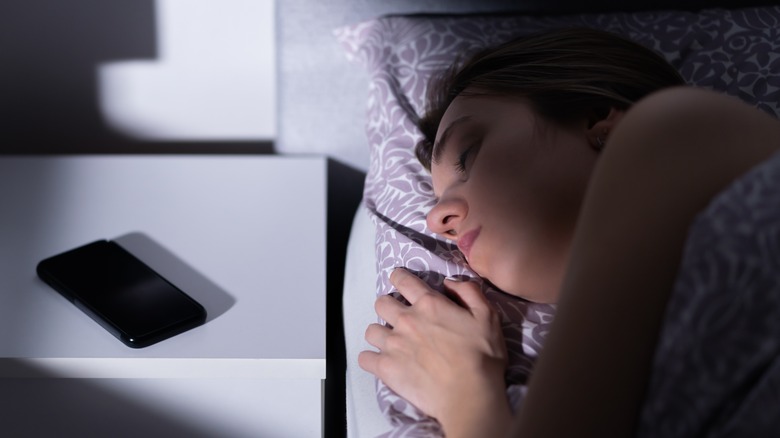Want To Hack Your Way To Better Dreams At Night? Follow These Tips
Do you ever find yourself dreaming of... well, dreaming? Dreaming isn't just a common occurrence in sleep cycles. It's a result of healthy sleep, says the Sleep Foundation. What your dreams reveal about your health is that when you get good sleep and enter a deep sleep state that produces dreams, you can have better cognitive and emotional health. Dreams can create sharper memory retention, fewer food cravings, and faster mental processing. On the flip side, when you don't sleep, you're at risk for failing body systems or organs like the brain.
Dreaming has also been linked to inspirational thinking. Gone are the days of metaphorically telling people to follow their dreams, and now, thanks to newer sleep studies and dream-to-inspiration testimonies of the past, they literally can! Just look at Paul McCartney, who claimed to hear the hook for his hit "Yesterday" in his dreams. Or perhaps Periodic Table creator Dmitry Mendeleev, who also answered why we need to dream by making a scientific discovery mid-sleep, as noted by UC Berkley's Greater Good Magazine.
Correlations between sleeping and creative dreams help us understand why our minds crave such epic dream states. They've also led us to hacks to achieving such epic dream states and simultaneously helping us achieve the best quality sleep our bodies offer.
When do dreams occur
Dreams often occur at the deepest part of our sleep cycle: REM (or rapid eye movement) sleep. It's imperative to allow your body to enter REM because, in this stage, your brain activity is reaching an all-time high while your body is burning calories faster. However, only 25% of sleep happens in REM, so knowing how to access that deep and health-enriching state is crucial.
When hacking our way to better dreams, it's important to note there are both mental and physical ways to achieve this. One hack is to hit two birds with one stone. Eliminate screen time and R-rated content before bed and turn to soothing or light content. Soaking in calming content can affect your mood and how quickly and easily you can slip into REM.
Understanding brain basics means understanding sleep, and ultimately, the foundation of REM stems from a balanced mental, peaceful state. Pause before heading to bed and revisit anything that makes you happy: old photographs, a good book, praying, or tracking gratitude. Training your brain to produce happy thoughts will help ease your body into a steady REM sleep cycle.
The placebo effect
The placebo effect may be the code to hacking the ultimate dream state because of its ability to trick the brain into thinking or feeling specific content. A placebo effect can act both subjectively (in pain, mood, and emotions) and non-subjectively, like blood pressure.
Placebo effects act in correlation with the brain to anticipate change physically. Then, after a mental regroup, it initiates change instantly, giving your subconscious little to no time to process. This ultimately can initiate a deep sequence of dreams.
Some of the most valuable hacks incorporate a placebo effect, tricking and training your mind to anticipate a change in your body. For example, your sleeping position may affect much more than you think, linking to different kinds of dreams based on what position you're in. For instance, sleeping on the left side is associated with nightmares, while the right side produces dreams of peace, claims Psychology Today. If you sleep on your stomach, don't panic — but that position is known for being linked with feelings of smothering and certain erotic dreams. The foods you eat also play a part in this, with different cheeses and caffeine products resulting in vivid dreams.


